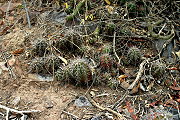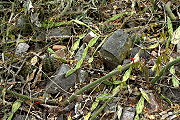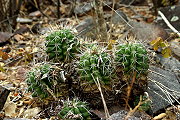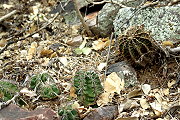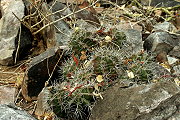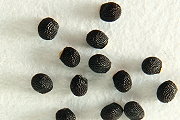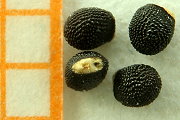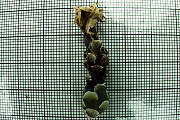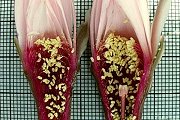Gymnos from A to Z
Gymnocalycium paediophilum Schütz ex F. Ritter
Gymnocalycium paediophilum is - in my opinion - a striking and distinctive species which so far was found only on top of a mound on the Cerro Leon. It only grows on this mountain at a height of at least 220 metres, never in the plain.
This habitat is a relic site. The plants are closely related to G. chiquitanum (flowers and seeds) and G. chacoense (seeds), but took a different development due to their completely isolated location.
Plant
The stem is strongly sprouting at the base, in old age short-stemmed, up to 120 mm in diameter and up to 200 mm in length. The epidermis is dull, light to dark green. Mostly 7 ribs, rarely up to 10, which are rounded, slightly protuberant and more pronounced in old plants and which reach a height of up to 26 mm.
Old plants have a crosswise bulge above the areole.
Radial spines: 5-9, spicular, the ones at the bottom often longer, up to 30 mm in length, reddish brown when freshly sprouted, later on grey with a brownish top. Up to 4 central spines, grey with a brownish top, rarely completely grey, up to 40 mm in length; above the central spine are up to 4 smaller, shorter and thinner central thorns. The spines have a rough surface.
Seed
The fruit has a blue-green colouration with pinkish scales, is juicy and has an oval to spherical appearance. The pulp is white. When ripe, the fruit rips lengthwise and is 5-15 mm long and 5-15 mm wide.
The seeds are 0,7–1 mm long and up to 0,8 mm wide. The testa is dark reddish brown to black, dully gleaming and finely protuberant. The area of the hilum is oval, whitish and has a small border fringe.
Seed group: Sugbenus Microsemineum Schütz.
Flower
The flowers are up to 80 mm in legth and diameter. During budding, the flower is cream-coloured to yellowish, during anthesis it is white to lightly pink. The colouration varies greatly depending on location and age of the flower. The stylus is pink and not "whitish", as stated in the initial description by Ritter.
The filaments are also pink and spread across the whole base of the flower. While the bottom-most filaments lie against the stylus, the ones located above are densely on top of each other and tower above the stylus.
